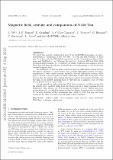Files in this item
Magnetic field, activity, and companions of V410 Tau
Item metadata
| dc.contributor.author | Yu, L | |
| dc.contributor.author | Donati, J-F | |
| dc.contributor.author | Grankin, K | |
| dc.contributor.author | Collier Cameron, A | |
| dc.contributor.author | Moutou, C | |
| dc.contributor.author | Hussain, G | |
| dc.contributor.author | Baruteau, C | |
| dc.contributor.author | Jouve, L | |
| dc.contributor.author | the MaTYSSE collaboration | |
| dc.date.accessioned | 2019-11-08T13:30:04Z | |
| dc.date.available | 2019-11-08T13:30:04Z | |
| dc.date.issued | 2019-11 | |
| dc.identifier | 262928356 | |
| dc.identifier | d3954a41-8771-40be-974d-04bcc91cf4d2 | |
| dc.identifier | 85075244902 | |
| dc.identifier | 000489302400081 | |
| dc.identifier.citation | Yu , L , Donati , J-F , Grankin , K , Collier Cameron , A , Moutou , C , Hussain , G , Baruteau , C , Jouve , L & the MaTYSSE collaboration 2019 , ' Magnetic field, activity, and companions of V410 Tau ' , Monthly Notices of the Royal Astronomical Society , vol. 489 , no. 4 , pp. 5556-5572 . https://doi.org/10.1093/mnras/stz2481 | en |
| dc.identifier.issn | 0035-8711 | |
| dc.identifier.other | Bibtex: 10.1093/mnras/stz2481 | |
| dc.identifier.other | ORCID: /0000-0002-8863-7828/work/64360623 | |
| dc.identifier.uri | https://hdl.handle.net/10023/18886 | |
| dc.description.abstract | We report the analysis, conducted as part of the MaTYSSE programme, of a spectropolarimetric monitoring of the ∼0.8 Myr, ∼1.4 M⊙ disc-less weak-line T Tauri star V410 Tau with the ESPaDOnS instrument at the Canada–France–Hawaii Telescope and NARVAL at the Télescope Bernard Lyot, between 2008 and 2016. With Zeeman-Doppler Imaging, we reconstruct the surface brightness and magnetic field of V410 Tau, and show that the star is heavily spotted and possesses a ∼550 G relatively toroidal magnetic field. We find that V410 Tau features a weak level of surface differential rotation between the equator and pole ∼5 times weaker than the solar differential rotation. The spectropolarimetric data exhibit intrinsic variability, beyond differential rotation, which points towards a dynamo-generated field rather than a fossil field. Long-term variations in the photometric data suggest that spots appear at increasing latitudes over the span of our data set, implying that, if V410 Tau has a magnetic cycle, it would have a period of more than 8 yr. Having derived raw radial velocities (RVs) from our spectra, we filter out the stellar activity jitter, modelled either from our Doppler maps or using Gaussian process regression. Thus filtered, our RVs exclude the presence of a hot Jupiter-mass companion below ∼0.1 au, which is suggestive that hot Jupiter formation may be inhibited by the early depletion of the circumstellar disc, which for V410 Tau may have been caused by the close (few tens of au) M dwarf stellar companion. | |
| dc.format.extent | 17 | |
| dc.format.extent | 5866889 | |
| dc.language.iso | eng | |
| dc.relation.ispartof | Monthly Notices of the Royal Astronomical Society | en |
| dc.subject | Magnetic fields | en |
| dc.subject | Techniques: polarimetric | en |
| dc.subject | Stars: imaging | en |
| dc.subject | Stars: individual: V410 Tau | en |
| dc.subject | Stars: rotation | en |
| dc.subject | QB Astronomy | en |
| dc.subject | QC Physics | en |
| dc.subject | DAS | en |
| dc.subject.lcc | QB | en |
| dc.subject.lcc | QC | en |
| dc.title | Magnetic field, activity, and companions of V410 Tau | en |
| dc.type | Journal article | en |
| dc.contributor.institution | University of St Andrews. St Andrews Centre for Exoplanet Science | en |
| dc.contributor.institution | University of St Andrews. School of Physics and Astronomy | en |
| dc.identifier.doi | 10.1093/mnras/stz2481 | |
| dc.description.status | Peer reviewed | en |
| dc.identifier.url | https://arxiv.org/abs/1909.01199v2 | en |
This item appears in the following Collection(s)
Items in the St Andrews Research Repository are protected by copyright, with all rights reserved, unless otherwise indicated.

